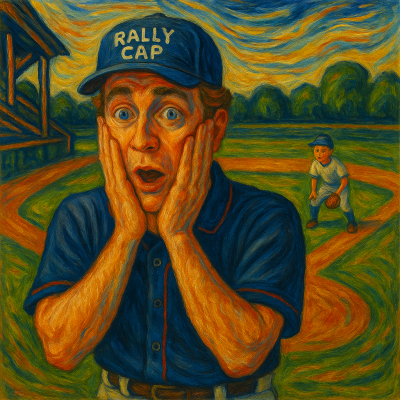Note: This post was written way, way back in 2018. I’m happy to say my son still plays baseball and loves it.
Fears H ave a Back Story
ave a Back Story
On the afternoon of my debut as an U7 baseball coach, I caught myself wishing for rain. Not a thunderstorm—just enough drizzle to make the diamond unplayable and buy me 24 hours of emotional reprieve. It wasn’t the kids I feared. It was the parents.
There’s something odd about that: a grown adult, seasoned therapist, and reasonably competent father, secretly hoping to be saved from a pack of five-to-seven-year-olds by cloud cover. But fear has a way of bending logic. It brings old stories forward.
Sometimes these stories don’t start on the ball field when you’re 40.
They started when we were kids.
The Fear Before Practice
“What have I gotten myself into?” I kept thinking. I love baseball. I love being with my son. The idea of teaching kids how to throw and catch—well within my wheelhouse.
Uncertainty wasn’t the issue. The kids weren’t what I feared.
The adults were.
I’ve seen adults yell at Jets games. I’ve watched people throw things at ballparks. I’ve heard grumbling at community events over matters far smaller than whether a seven-year-old rounds first correctly. The parent-bleachers, in their own way, can be more intimidating than any opposing team.
I didn’t fear doing a bad job.
I feared being judged as doing a bad job.
(And I wasn’t applying Ross’ Razor to the situation.*)
Which leads to my navel gazing rather than keeping my eyes up on those around me.
As a therapist, I spend my days helping people tune into each other. But this wasn’t my office. This was public. This was unpredictable. And this was parent culture, where sometimes one raised eyebrow can feel like a Yelp review in real time.
So why was this particular fear so sticky?
To answer that, we have to go back about thirty years.
Let Me Introduce My 8-Year-Old Self
Every adult carries a younger self around—somewhere between the lungs and the sternum—whose job is to remind us of our oldest fears. Mine is an eight-year-old boy on the field at recess.
A bunch of kids were kicking a ball around, and I wanted in. They didn’t pass it my way—and looking back, I can see I didn’t really know how to step in, either. It wasn’t tragedy; but it had this semi-tragic outcome: subconsciously I connected sports with not fitting in.
It wasn’t dramatic. No shoving, no insults. Just exclusion—clean, quick, unmistakable. The kind that lodges itself quietly, precisely because nothing dramatic happens. And then assumptions fit in.
It’s strange how many years can pass before that little version of ourselves wakes up again. But he does wake up—usually at inconvenient times. Like two hours before coaching U7 baseball.
When Little Lindsey appears, he doesn’t show up shouting.
He just taps on the inside of my ribs and whispers:
“What if they think you suck?”
The Work of Reassuring a Child Who Still Lives in You
When that little voice surfaces, I don’t argue with it. That never helps. Children—inner or otherwise—don’t calm down by hearing why they shouldn’t feel what they feel. They calm down when we meet their basic needs. The trick is figuring out the need. Is it food? Play? A nap? Emotional support?
So I start with the same thing I offer my clients:
Acknowledgement
“Hey there. I’m sorry you feel so afraid.”
It sounds simple. It is simple. And simplicity, in emotional work, is often mistaken for weakness when it’s actually the foundation.
Then I move to the second step: recognizing the facts that gave the fear teeth in the first place.
Yes, kiddo, you’ve been rejected before.
Yes, it hurt.
Yes, that memory shaped you.
You’re not making this up.
By not arguing with the emotion, I create space to soothe it.
And that opens the door to the third step: action. Not forceful, not frantic. Purposeful.
I went over the practice plan. Checked the equipment. Reviewed the Rally Cap drills. Teaching, preparing, engaging—these things pull me out of the eight-year-old self and back into the adult who knows what he’s doing.
It’s hard to feel like a scared kid while sorting buckets of baseballs.
And Then They Were Wonderful
My son and I arrived at the park early. We set up. Parents drifted in.
And then the surprising thing—the data point that Gladwell would smirk at—happened:
The parents were fantastic.
Warm. Helpful. Engaged. They caught balls, pitched (bravely), coached bases, laughed, supported their kids, supported me. No mutiny. No critique. No bleacher politics.
Just a generous little community, assembling itself one lawn chair at a time.
And Little Lindsey?
He loosened his shoulders.
He took in the scene.
He updated his data set.
It turns out the world is not composed solely of eight-year-old soccer fields.
Pain Creates the Need; Acceptance Creates the Way
Here’s the pattern:
- If we had never been scared kids, we wouldn’t have grown up to be the caring people we are.
- If we had never felt excluded, we wouldn’t seek out the tools that help us include others. (Like you’re doing right now.)
- If we had never been loved and accepted, we wouldn’t know how to help others know that they are good enough just the way they are.
The pain creates the need.
The acceptance shows the path.
And on that small baseball diamond—parents chatting, kids swinging wildly at soft tosses, my son beaming—something in me settled.
The fearful eight-year-old and the grown adult both got to feel what teams are supposed to feel like. There really is nothing like that feeling of good-enough-ness that comes in moments like that: when we know we belong exactly where we are and with exactly who we’re with.
—
Footnote:


